[Retracted] Design and Implementation of Scientific Management and Engineering Intelligence Based on Multivariate Analysis
Abstract
This paper takes the intelligent engineering as an example and uses the Work Breakdown Structure (WBS) tool to decompose the intelligent engineering into specific subsystems and describe each subsystem. In the field of intelligent engineering construction, it is impossible to ensure that the construction project will not be changed. To reduce scope changes, efforts can be made in three aspects: first, to accurately locate project requirements and find enough work to be done; second, to scientifically define the scope of the project and delete unnecessary work; and third, to effectively control scope changes. Ensure that all work is done to achieve the project goals. This paper starts from the actual project management experience, conducts a comprehensive summary and refinement, proposes key strategies and methods for project scope management, and puts forward the following points of view. Intelligent design should be completed by professional design agencies, and intelligent construction should be completed by professional construction teams. There should be standards for intelligent acceptance to follow. Hope this article will be helpful for project managers.
1. Introduction
With the improvement of people’s living standard and quality, the advancement of science and technology, and the upgrading of intelligent equipment, people’s standards for building intelligentization are constantly improving. Quality control is currently the focus of attention in the domestic intelligent building industry. In order to make the intelligent building live up to its name and play its due investment effect, this paper makes an analysis and discussion on the scope management in the intelligent project [1].
Intelligent building is the product of the information age, and it is the organic combination of modern architectural art and information technology. According to the definition of the “Intelligent Building Design Standard” (GB/T50314-2015) promulgated by the state, an intelligent building is a “Taking the building as the platform, based on the comprehensive application of all kinds of intelligent information, it integrates architecture, system, application, management and optimal combination, and has the comprehensive intelligent ability of perception, transmission, memory, reasoning, judgment and decision-making, forming an integration of human, building and environment, and providing people with a safe, efficient, convenient and sustainable functional environment.” [2].
The most basic of building intelligence is to have the following: “the ability to perceive changes in the environment and use functions; the ability to transmit data signals to the main control equipment; the ability to comprehensively analyze data information; the ability to make decisions and respond, and issue instructions.” This requires each subsystem to be highly automated but also requires a high degree of integration of each automation subsystem; otherwise, it will not meet the requirements of intelligence. Be sure to avoid the “vegetative” phenomenon in the automation of subsystems, such as swiping cards to enter and exit the system. If only the antitheft problem is considered in the system design, and the fire prevention problem is not considered, when a fire occurs, the system will become an obstacle to escape. Therefore, it is necessary to propose an intelligent IC identification system. The intelligent system includes office automation (OA), communication automation (CA), and building automation (BA), the so-called 3A intelligence [3]. In order to publicize, some builders advertise that the building intelligence reaches 7A and 8A, which is actually the result of refining the automation system. For example, building automation is divided into building management automation, building control automation, building fire protection automation, building safety monitoring automation, building air conditioning automatic control, etc. The integration of automation equipment built on the building’s integrated wiring system has formed the optimization of the building’s structure, systems, management and services, and the association between them, providing an efficient, convenient, comfortable, and safe environment with conditions, so that both owners and users can obtain higher economic benefits [4].
At present, “developing a circular economy and building a conservation-minded society” has become the theme of my country’s economic development and social progress. China has the world’s largest construction market. How to build more green buildings, ecological buildings, and sustainable buildings is an important issue. It is the problem before us. Regardless of green buildings, ecological buildings, or sustainable buildings, they all focus on people-oriented and sustainable development, building an indoor environment that meets the requirements of human work and life, emphasizing health, comfort, efficiency, and convenience, which is also the ultimate goal of intelligent buildings. However, in order to achieve such a goal, there is still a big gap to analyze the current situation of domestic intelligent building projects. In particular, the building volume is large, the investment is large, and the energy consumption is high. The level of building intelligent engineering largely determines the realization of the overall goal of the building [5].
My country’s intelligent buildings are still in the development stage, the engineering construction level is not high, and the project quality is unsatisfactory. Many buildings have incomplete functions and malfunctions of intelligent systems, and some building intelligent projects cannot even be completed, resulting in delays in the entire project period. Relevant literature shows that only 20% of the building control systems in my country’s completed building intelligent systems can operate normally and play an important role, 45% are abnormal but still usable, and 35% cannot be opened for use or used-discarded after a period of time due to serious defects or malfunctions. It can be seen that the failure rate of building intelligent systems is very high, resulting in huge investment waste and economic losses. If such a problem occurs in some landmark buildings, it may also have serious political, economic, and social impacts [6].
2. State of the Art
The project is that people organize human, material, financial, and other resources through efforts and various methods and carry out an independent one-time or long-term indefinite work task according to the relevant planning and arrangement of the business model, in order to achieve the goals defined by the quantity and quality indicators. A project is a one-time work task that is interconnected to achieve a certain purpose under the constraints of given resources and requirements. The project has a clear goal, and the goal is a product or a desired service. Each item is unique and has unique properties. Each project needs to be implemented with limited resources, and there will always be some changes in internal and external factors in the specific implementation, so the project will also have uncertainty. The project cannot be repeated with a one-off, the result of the project is irreversible, and no matter how the project ends, the result is determined [7].
An opposite concept to a project is an assignment. Activities and projects are two types of activities that are closely related to the development of an enterprise. The basic activities of an enterprise can be divided into activities and projects. Jobs refer to the continuous and repeated activities in the enterprise, which are those repetitive tasks in the enterprise. It only maintains the daily operation of the enterprise and does not determine the development of the enterprise. A project is a one-time task with inputs and outputs. It is a general term for multiple related tasks that meet a series of specific goals within a certain period of time. It is a carrier to achieve corporate strategic goals and is a basic element of corporate development. It plays a vital role in the development of the company. The establishment of an enterprise itself is the beginning of a project. It enables the enterprise to form the ability to provide a certain product or service through a new project to meet the needs of the market or customers, so as to obtain profits, survive and develop, and repeat operations on this basis.. With the emergence of factors such as aging equipment, outdated technology, backward management, and environmental and market changes, such repeated operations can no longer meet the needs of the market, and the enterprise may not be able to survive or develop. At this time, it is necessary to implement projects such as technological transformation, new product development, management innovation, and mechanism innovation, so that enterprises can keep up with the pace of development of the times. In the entire development process of the enterprise, the alternation of projects and assignments is always repeated. It can be seen that the operation leads to the quantitative change of the enterprise, and the project causes the qualitative change of the enterprise, which is the driving force for the leap-forward development of the enterprise [8].
Project management is the manager of the project, under the constraints of limited resources, using systematic viewpoints, methods, and theories to effectively manage all the work involved in the project, that is, planning, organizing, commanding, coordinating, controlling, and evaluating the entire process from the start of the project’s investment decision to the end of the project to achieve the project’s goals. Much of the knowledge and many tools and techniques required to manage projects are unique to project management, such as work breakdown structures, critical path analysis, and realized value management. However, understanding and applying the above knowledge, skills, and techniques alone is not enough to manage projects effectively. Effective project management requires the project management team to understand and utilize knowledge and skills in several areas of expertise [9].
Project scope management refers to the process of defining and controlling what is and is not included in the project. This process is used to ensure that the project team and project stakeholders have a common understanding of the project products that are the project results and the processes used to produce those products. Project scope management ensures that the project contains all the work to be done and only the required work. It mainly involves defining and controlling what is in the project scope and what is not. The basic content of scope management includes project scope management as shown in Figure 1 [10].

Traditional construction vehicles have always had the disadvantages of high fuel consumption and high emissions. According to the data from the “China Mobile Source Environmental Management Annual Report,” in 2019, the NOx emissions from construction vehicles in China exceeded 3.335 million tons, accounting for about 29.5% of the total mobile source NOx emissions, and the particulate matter emissions exceeded 174,000 tons, which is about the same as motor vehicle particulate matter, 2.4 times the emissions. With the increasingly prominent global energy crisis and environmental pollution problems, energy conservation and environmental protection have become an important theme in today’s social development: Limits and Measurement Methods (GB 20891-2014) revised version and “Technical Requirements for Pollutant Emission Control of Non-Road Diesel Mobile Machinery” (HJ 1014-2020) [11]. As shown in Figures 2 and 3, with the upgrading of emission standards at each stage, the NOx and particulate matter emission limits have become more stringent.

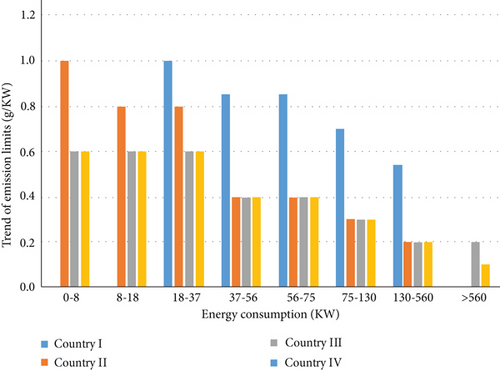
It is of great significance to study the energy management technology for hybrid electric engineering vehicles for the development of hybrid electric engineering vehicles. Based on the development needs of the industry, this topic relies on the National Natural Science Foundation of China’s project “Distributed Electric Drive Articulated Special Vehicle Drive Force Distribution and Coordinated Control in Unstructured Terrain” to study the energy management of hybrid engineering vehicles and its intelligent methods. The technological innovation and transformation of construction vehicles lay a theoretical and practical foundation [12].
3. Methodology
3.1. Risk Identification and Analysis of Intelligent Engineering Projects
3.1.1. Identification of Risk Factors
Project risk identification is the premise of risk control. Only by accurately identifying the potential risks of the project can we formulate effective countermeasures for risks and minimize project losses. Through the analysis in Chapter 3, the risk sources of GT Company’s intelligent engineering projects are multifaceted. From the perspective of risk sources, project risks include risks from party A, risks from general contractors, and risks from subcontracting [13]. The types of risks are complex and diverse, and the purpose of the thesis research is to find out the potential risks of the project from the intricate influencing factors. Commonly used risk identification methods in project management include Delphi method, brainstorming method, and risk checklist method. In the process of risk identification of GT Company’s intelligent engineering project, based on WBS theory, as much as possible the potential risks of the project were identified through the brainstorming method and risk checklist method, and a list of risk factors was sorted out.
3.1.2. Comprehensive risk identification
For the current situation and existing problems of the abovementioned intelligent projects, use the brainstorming method and the risk checklist method to carry out risk identification. The specific implementation steps of the brainstorming method are as follows: a brainstorming team of 10 people is formed by experts and project managers from the construction unit, design unit, construction unit, supervision unit, supply unit, etc. The possible risk factors in the company’s intelligent engineering project were recorded by two assistants to corroborate each other. The team members decompose the familiar projects based on the WBS project, divide the possible risks of intelligent engineering projects into five categories according to their experience, build a two-dimensional matrix with the specific work of each link of the project, and then speak and talk in turn. Identify the list of risk factors by presenting potential risks in the project. Sequential speaking: each speech is recorded, and the speech is repeated until all possible risk factors have been considered; open talk: all group members do not need to be in order and speak freely [14]. The flowchart of the brainstorming method is shown in Figure 4
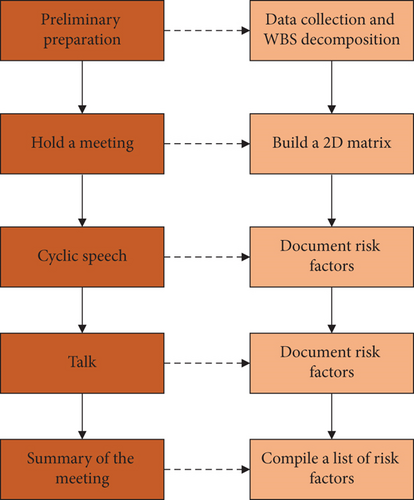
The team members divided the main risks of intelligent engineering projects into five categories based on past experience, namely, market risk, technical risk, design risk, management risk, and contract risk, and constructed a two-dimensional matrix with the minimum task module decomposed by WBS and the brainstorming team. Based on this, members discuss and analyze the risks that may occur at each work point and record them to form a preliminary risk list [15].
3.2. Risk Analysis Based on AHP
The analytic hierarchy process is classified according to the characteristics of risk factors to form an orderly hierarchical structure. Through the subjective judgment of professionals, quantitative assignments are made to each layer and each element, and the method of mathematical matrix is used. The weight of each risk factor is calculated, and the risk level is ranked according to the weight value, so as to realize the evaluation of the size of each risk factor. Analytic hierarchy process has the characteristics of clear logic and strong coherence. The first step in using AHP is to establish a project AHP framework according to the requirements of AHP [16].
3.2.1. Construct Judgment Matrix
First, construct the first-level risk factor judgment matrix. The first-level risk factors are the above five factors from B1 to B5. The relative importance of Bi to Bj (i, j = 1, 2, 3, 4, 5) is determined by the values 1~9 and their reciprocal representation. Through the qualitative analysis of the hierarchical structure diagram and the abovementioned risk evaluation matrix, considering the influence of the lower-level risk factors on the upper-level risk factors, the first-level risk evaluation matrix is obtained as shown in Table 1.
| X | B1 | B2 | B3 | B4 | B5 |
|---|---|---|---|---|---|
| B1 | 1 | 7 | 3 | 5 | 1/3 |
| B2 | 1/7 | 1 | 1/5 | 1/3 | 1/9 |
| B3 | 1/3 | 5 | 1 | 3 | 1/5 |
| B4 | 1/5 | 3 | 1/3 | 1 | 1/7 |
| B5 | 3 | 9 | 5 | 7 | 1 |
3.2.2. Hierarchical Order
The abovementioned X-B judgment matrix is sorted in a single hierarchy, that is, the weight of the first-level risk factor on the overall impact of the project is calculated, and the consistency of the judgment matrix is verified. The hierarchical single ordering can be transformed into the problem of calculating the eigenvalues and eigenvectors of the judgment matrix, that is, calculating the eigenvalues and eigenvectors of the judgment matrix B satisfying BW = maxW. Among them, λmax is the largest eigenroot of B [17], W is the normalized eigenvector corresponding to Amax, and the componentWofW; (−1, 2..⋯is the weight of the corresponding factor single ordering.
In general, for 1~9 order matrix, the average randomness-consistency index (denoted as RI) is shown in Table 2.
| Order | 1 | 2 | 3 | 4 | 5 | 6 | 7 | 8 | 9 |
|---|---|---|---|---|---|---|---|---|---|
| RI | 0.00 | 0.00 | 0.58 | 0.90 | 1.12 | 1.24 | 1.32 | 1.41 | 1.45 |
Therefore, the judgment matrix has the required consistency.
The normalized eigenvector W obtained from the X-B judgment matrix can be obtained—the ranking of the risk factors is as follows: contract risk, market risk, design risk, management risk, and technical risk.
3.2.3. Hierarchical Total Sorting
Hierarchical total ranking is a comprehensive ranking of secondary risk factors. According to the weights of the same level of risk factors relative to the importance of the previous level, the importance weights of each risk factor at this level to the entire project can be calculated, and the overall ranking of the second-level risk factors can be obtained, through consultation with experts and authoritative personnel. Then, the judgment matrix table of secondary risk factors is obtained, and the maximum eigenvalue and normalized eigenvector of each judgment matrix are obtained, respectively, as shown in Table 3.
| B1 | C1 | C2 | C3 |
|---|---|---|---|
| C1 | 1 | 3 | 5 |
| C2 | 1/3 | 1 | 3 |
| C3 | 1/5 | 1/3 | 1 |
Therefore, the management risk judgment matrix B4-C has satisfactory consistency.
3.3. Application of Energy Management Strategy Based on Q-Learning
As a common paradigm in reinforcement learning problems, Markov decision process often uses dynamic programming (DP) to solve iteratively for optimization. It is used to simulate the randomness strategies and rewards that can be realized by agents in the environment where the system state has Markov properties. The basic idea is to repeatedly evaluate and optimize the strategy based on Bootstrapping based on the Bellman equation. However, this evaluation process is only a regular behavior that relies on prior knowledge and cannot be applied to changing and complex environments. In the energy management problem, the interaction information between the system and the environment is dynamic and unpredictable. As mentioned in Chapter 1, energy management strategies based on reinforcement learning have made a lot of progress in the automotive field as a new generation of intelligent management methods, and the application of Q-learning method is the most representative. On this basis, this paper applies the Q-learning idea to the solution of the Bellman optimality equation for the energy management of hybrid electric vehicles [18]. For the solution of this kind of sequential optimization decision-making problem with delayed return, this paper adopts the Q-learning algorithm. Iteratively computes the state-action value function Q(s, a) of the Markov decision process [19].
After initializing Q(s, a) to an arbitrary value, set the number of iterations and start to repeat the iterative process: select the action corresponding to the current state S according to the current strategy and observe the next state S′ according to the state transition matrix P, and calculate the Q value. At the end of the iteration, select the action a that maximizes the Q value in the abovementioned overcharge. In order to prevent the agent from being unable to explore potential optimal actions because the agent pays too much attention to the immediate benefits, a jitter strategy (ε − greedy(S, Q)) is added to help the agent better explore in the action space [20, 21].
3.4. Basic Principles of Dyna-Q-Learning Algorithm
In model-free learning methods such as Q-learning, the agent directly interacts with the environment to obtain data for optimizing policies/actions without prior knowledge. Due to the randomness of the interactive learning process between the agent and the environment, in order to form a cognition of the environment, the agent needs to interact a lot to obtain enough sample data. Although this blind exploration process can achieve gradual convergence of optimization results, its low learning efficiency hinders the application of model-free methods in the real physical world. The Dyna-Q-learning framework provides an effective solution to the above problems.
In the Dyna-Q-learning framework, the ability of the agent to learn directly in the model-free method is retained, and by introducing a virtual model, the agent is given the ability to simulate interaction with the virtual model and learn indirectly. The direct learning process is the same as model-free learning, while the indirect learning process is to first use real experience to learn and form a model that can map the characteristics of the environment. The process by which the agent interacts with the model and acquires virtual experience to update or improve the value function is defined as planning.
It is worth noting that Dyna-Q-learning not only means that the agent can no longer completely rely on the interactive experience of the real environment, but also has the following characteristics: (1) The real experience data obtained by the agent through direct learning is no longer simply used. It is also used for the learning and improvement of virtual models based on the update of value functions or policies. Therefore, the utilization of data samples is greatly improved.
(2) The efficiency of the agent acquiring experience through the virtual model is much higher than the interaction process in the real environment. Therefore, after completing model learning, indirect learning is more efficient and less expensive than direct learning
The abovementioned direct learning and indirect learning processes can be implemented based on the same learning algorithm, and the difference lies in the way of acquiring experience samples. In Dyna-Q-learning, model learning and direct learning behavior may also occur simultaneously. With the continuous learning and updating of the virtual model in the background, it will gradually have a good ability to describe the characteristics of the real environment, thus helping the agent to plan more effectively through the indirect learning method.
4. Result Analysis and Discussion
4.1. Overall Response Strategy of Project Risk
4.1.1. Risk Avoidance
Risk avoidance is when the project risk is very likely to occur, the severity is beyond the controllable range, and there are no good countermeasures to correct it in time, choose to abandon the project or part of the project, change the project goals and action plans, and avoid project risks—a measure. Before using this kind of measure, the judgment of the risk level needs to have enough confidence and needs to be verified by multiple parties. At the same time, new projects or new programs should be fully controlled to avoid new risks.
In engineering projects, the most used risk avoidance strategies are the selection of design plans and equipment purchase: the risk of design plans mainly comes from the designer’s consideration of comprehensiveness and the availability of selected technologies when designing plans. Risk avoidance strategies are used to deal with this problem. When there is a risk, start from the root cause, fully understand the actual situation of the project and the needs of the builder before the scheme design, reject vague definitions, formulate adjustment plans for possible design changes, do not use uncontrollable technologies, and do not employ insufficient qualifications or experience. The risk of equipment purchase comes from market supply and demand. The unstable market environment often leads to equipment price fluctuations or purchase restrictions. Risk avoidance strategies are adopted to address these risks. One is to purchase equipment in advance for backup, and the other is to choose another option.
Based on the above analysis, in the intelligent project of GT Company, risk avoidance strategies can be adopted for design risks and market risks, including the risk of design change, the risk of insufficient equipment supply, the risk of delayed equipment supply, and the risk of price fluctuations, so as to fundamentally eliminate these high risks.
4.1.2. Risk Mitigation
Compared with the risk avoidance method, project risk mitigation is a positive risk response method. In the process of project risk response, for the risk factors whose risk level is within the controllable range, adopt new technologies or new methods to reduce the possibility of risk occurrence, or minimize the loss when the risk occurs, and reduce the adverse impact of the risk on the project. Risk mitigation can be divided into risk prevention and loss suppression according to the execution time of risk response measures. The implementation before the risk occurs is called risk prevention, and the implementation when the risk occurs or after the risk occurs is called risk suppression.
Since the implementation of the intelligent project has already begun, the basic engineering of the project and most of the application systems have been implemented, and the control measures for most risk factors are implemented when the risk occurs, and the method of loss suppression is adopted for these risk factors. These risk factors include the following: design change risk, contract amount change risk, insufficient design plan optimization risk, design scalability risk, point design not meeting the actual needs of each system, slow project progress risk, party A’s unclear demand risk, compatibility risk between various systems, risk of the construction party’s entry time sequence, and equipment performance not meeting the expected risk. Project settlement, IT system migration, and data backup have not yet been implemented. We can formulate risk response plans before risks occur, which are risk prevention in risk avoidance. The risk mitigation in the risk management of this project is mainly reflected in the following: first, in the absence of a contract, both parties adopt an effective way to confirm key points to reduce denials, quarrels, and other behaviors; second, strengthen construction safety and quality assurance education, enhance the intensity and frequency of quality spot checks, and establish a sound reporting and feedback mechanism; third, learn the latest technology, observe star projects, and optimize the design plan as much as possible to reduce rework, control the progress, and make the project more optimized; fourth, broaden supplier channels and provide more choices for equipment and materials. Compared with risk avoidance strategies, risk mitigation strategies are less powerful, but risk mitigation is indeed a commonly used response strategy in risk response.
4.2. Measured Results and Analysis
- (1)
The model adopts the steady-state modeling method, which leads to the lack of some features related to dynamic characteristics
- (2)
Since the modeling of the controller is a complex problem, various factors such as response speed and smoothness need to be considered according to different control objects, and each controller in the system cannot be modeled one by one during the simulation process
After the agent is learned, the two selected verification conditions correspond to the SOC change trajectory as shown in Figure 5. Although different data differences lead to significant differences in power requirements, the trajectories of the state of charge of the Dyna-Q-learning algorithm-based management strategy are still within reasonable limits. In addition, the state of charge values converged to around 80% at the end of the cycle. The SOC sustaining capability shown here reflects that the energy management method proposed in this chapter has a good adaptability to the changes in operating conditions during the working cycle.
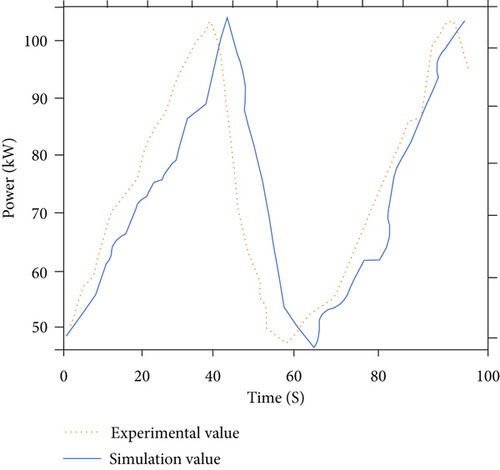
To evaluate the real-time performance of the proposed method, this paper compares the learning curves of Dyna-Q-learning and Q-learning under the same operating conditions. Figure 6 is the average step curve of the agent after 25 rounds of training, and each process sequence corresponds to a complete working cycle. In the Q-learning method, the agent converges the average number of training steps below 300 in the 20th process sequence, while the Dyna-Q-learning method achieves the above convergence goal in the 9th process sequence. The learning curves of both methods show a clear trend of convergence, while the learning efficiency of Dyna-Q-learning is nearly 55% higher than that of Q-learning. This is mainly due to the more efficient and fast interaction method provided by the virtual world model for the agent, which improves the learning efficiency: in the process of interacting with the real physical environment, the agent’s exploration of the environment and accumulation of experience are very time-consuming, which results in slower convergence of the trajectory in the early stages of learning. In contrast, the agent in Dyna-Q-learning achieves more efficient planning by invoking the virtual experience in the virtual world model. Computational time is required to train 50 process sequences for Q-learning and Dyna-Q-learning, respectively. The computing time of Dyna-Q-learning is about 36% less than that of Q-learning, and the real-time performance is significantly improved as shown in Figure 7.
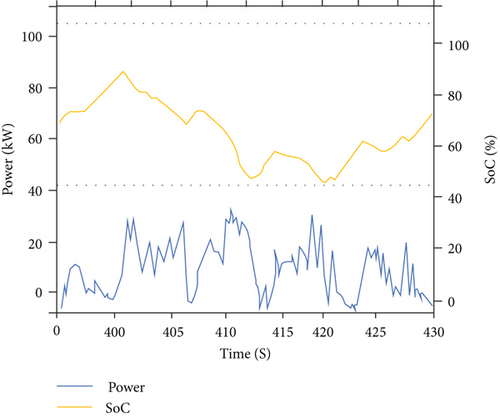
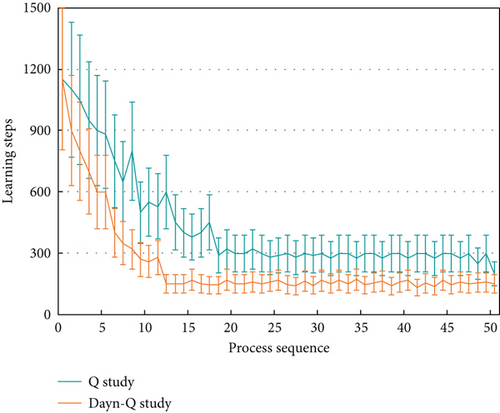
5. Conclusion
- (1)
After learning the agent, the two selected verification conditions correspond to the SOC change trajectory. Although different data differences lead to significant differences in power requirements, the charging state trajectory of the management strategy based on Dyna-Q-learning algorithm is still within a reasonable range
- (2)
This paper compares the learning curves of Dyna-Q-learning and Q-learning under the same operating conditions. The learning efficiency of Dyna-Q-learning is nearly 55% higher than that of Q-learning. The computing time of Dyna-Q-learning is about 36% less than that of Q-learning, and the real-time performance is significantly improved
- (3)
In the process of intelligent project scope management, it is a very common phenomenon that the project scope is not clearly defined. I think there are three reasons: First, there is no perfect project management system to guide project management. This situation is the worst. If this is the reason, then the possibility of project success is very small, and it only depends on the management and leadership of the project manager. Most projects end in failure; second, there is no clear and standardized scope change control process for the project. The enterprise has a management system, but it is not perfect and standardized, and it fails to play an effective guiding role in the formulation of the change process of the project team. Change is inevitable, and as long as it is effectively managed and controlled, it can also achieve satisfactory results for all parties; third, the definition of the scope of intelligent engineering is not clear enough, and the degree of quantification and verification cannot be achieved. Most of the time, it is a qualitative requirement, not a quantitative one. These vague requirements are the root cause of subsequent projects
Conflicts of Interest
The authors declare that they have no conflicts of interest.
Acknowledgments
The authors would like to show sincere thanks to those techniques who have contributed to this research.
Open Research
Data Availability
The figures and tables used to support the findings of this study are included in the article.




